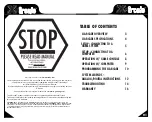
Start-up
TruVu™ VAVB3
-E2
CARRIER CORPORATION ©2022
Installation and Start-up Guide
All rights reserved
68
Demand limiting
Demand limiting is a cost-saving strategy to reduce energy consumption. The strategy expands the setpoints when
the system reaches one of 3 levels of consumption. With the expanded setpoints, the equipment works less,
thereby saving energy.
If the TV-VAVB3-E2 receives a demand limit signal through the network, it expands its setpoints based on the
demand level. The default amounts are:
•
Demand Level 1: 1 °F (.6 °C)
•
Demand Level 2: 2 °F (1.1 °C)
•
Demand Level 3: 4 °F (2.2 °C)
Linkage
The i-Vu® Control System uses linkage to exchange data between the zone terminals and their air source to form
a coordinated HVAC system. The system's air source controller, zone controllers, and bypass controller (if
applicable) are linked so that their data exchange can be managed by one zone controller configured as the
Master.
The basic linkage process is as follows:
1
The Master gathers data from the slave zone controllers such as occupancy status, setpoints, and space
temperature.
2
The Master performs mathematical calculations and algorithms on the data.
3
The Master sends the composite information to the air source.
4
The air source returns information such as mode, supply air temperature, and outside air temperature, if
present.
5
The Master passes that information to all slave zone controllers.
The following sections detail the process for VAV Systems and VVT Systems.
VAV Systems
The VAV Master continuously scans the system and gathers the following information from each zone:
•
Setpoints and space temperature
•
Zone size
•
Occupancy status
•
Damper position
•
RH and CO
2
values (if applicable)
















































